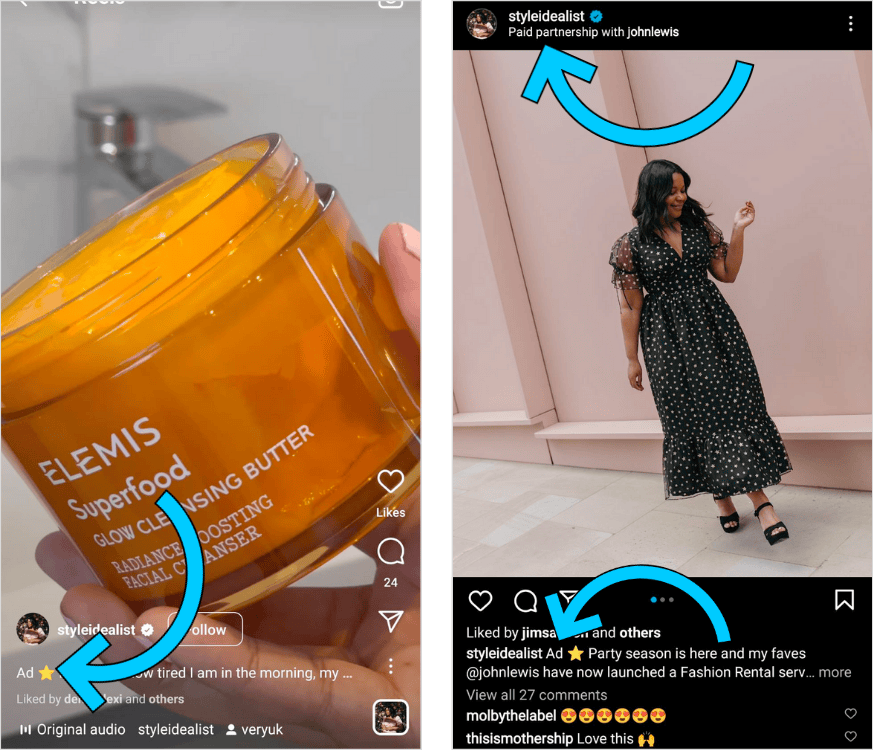What It Costs to Work With Influencers

Influencer marketing is one of the best ways for brands and businesses to reach engaged (and relevant) audiences. Yet, when it comes to pay transparency, influencer rates are still a complete mystery.
To unlock the secrets to influencer pricing, we’re breaking down how much do influencers make per post, what influencers look for in brand partnerships, and so much more!
Plus, we’ve included stats and insights from Later’s free Creator Rates Report — with data collected in 2023 — to help inform your influencer marketing strategy.
What Factors Impact Influencer Rates?
While the influencer marketing industry is set to grow to $21B in 2023, influencer rates are not one-size-fits-all.
From follower count to the type of collaboration, many factors ultimately determine an influencer’s unique final price.
Let’s dive into them:
1. Number of Followers and Engagement Rate
Typically, influencer rates closely depend on their follower count (and engagement rate).
Mid and Macro influencers, for example, have gigantic audiences — making them an excellent choice for campaigns where mass awareness is key:
However, this impressive social clout often comes at a cost — with the price of a sponsored Instagram post costing thousands of dollars.
On the flip side, Nano and Micro influencers have smaller but more engaged audiences, making them a great choice for brands looking to tap into hyper-niche communities:
Plus, budget-wise, Nano and Micro influencers are typically a more affordable choice compared to their Macro counterparts.
In fact, according to Later’s free Creator Rates Report, for a singular Instagram Reel, influencers can charge (as a baseline fee):
- Nano creators (0-10K followers): $100-$200
- Micro creators (10K-100K followers): $200-$1K
- Mid creators (100K-500K followers): $1.5K-$5K
- Macro creators (500K+ followers): $5K-$7K+
2. Social Platform
Before landing on a price, it’s important to consider whether the influencer is expected to create content for more than one social platform.
For example, do you expect them to post on Instagram and TikTok? Create a YouTube video, a few Tweets, and a LinkedIn post?
Common platforms to package into a brand partnership deal include:
· TikTok
· YouTube
Just remember, the more platforms added to the package = higher costs.
3. Type of Collaboration
As collaborations go, there are near endless ways that brands and creators can link up.
Here are the five most common influencer marketing partnerships:
A) Sponsored Content
Sponsored content can include anything from in-feed posts on Instagram to TikTok videos that feature a brand’s product or service.
![]()

It’s a great way for brands to tap into a treasure trove of potential customers.
TIP: Always be open and honest with your community by properly disclosing your sponsored Instagram posts.
B) Affiliate Marketing
Affiliate marketing is a way for influencers to earn a commission payment for the clicks or sales they drive on behalf of brands.
To earn this commission, influencers will use uniquely trackable links (known as affiliate links) to track how many clicks or sales were made.
To learn more about affiliate marketing, bookmark this: Affiliate Marketing for Influencers: How to Make Money on Instagram
C) Giveaways
An Instagram giveaway is a great tactic for encouraging engagement and reaching new audiences.
By collaborating with an influencer, brands can giveaway a newly launched (or popular) product, and drive brand awareness in the process.
Need help planning and hosting a giveaway? Read this: How to Host an Instagram Giveaway: A Step-by-step Guide
D) Instagram Stories Takeovers
Instagram Stories takeovers typically involve an influencer temporarily “taking over” a brand’s account.
During the takeover, the influencer will show how they use a brand’s products or services, providing valuable “real life” context along the way.
This type of partnership can help humanize a brand and make them come across as more relatable — rather than overly “salesy.”
E) Instagram Collab
Instagram Collab posts lets two users co-author the same post or Reel to their feed:
You’ll share views, likes, and comments — allowing you and the influencer to leverage and engage with each other’s communities.
Talk about a major exposure play!
4. Deliverables and Usage Rights
Certain partnerships may require more deliverables and therefore might come with a higher price tag.
Before collaborating with an influencer, decide on the following factors before setting a price:
· Deliverables: Will they be creating static images or video content like Reels? How many?
· Length of the contract: How long will the campaign or partnership run for? Is it a one-off partnership or ongoing?
· Usage rights: Will you use their content for promotional purposes or on other platforms? How long will you use their content?
· Exclusivity clause: Can they partner with a competitor during (or after) the campaign? How long will the clause be?
FYI: After surveying over 500 creators for our Creator Rates Report, these are the top three factors that impact an influencer’s rates:
1. Content format
2. Scope of work and resources required
3. Expected time to deliver and create content
Here’s How Much Instagram Influencers Make per Post in 2023
Since the influencer industry is still fairly new, there’s unfortunately no standardized pricing rule.
For example, if you were to ask an influencer on Instagram how much money they charge brands for sponsored posts, you may be surprised to see a scope of answers across the board:
However, after surveying over 500 creators and analyzing 29K Instagram posts, we discovered median rates for creators with various following tiers:
![]()

Our advice? Use these rates as a baseline, consider other factors like the scope of work required, and build a price tag from there.
How Can Brands Budget for Influencer Costs?
Like with any marketing campaign, you’ll want to get clear on what your goals are.
If your campaign is primarily related to brand awareness, you may work with a dozen creators.
On the other hand, if you’d prefer an ongoing campaign that lasts for a few months, you may consider only working with a few influencers.
Either way, take a look at your budget for the month, quarter, or year, and be realistic with what you can afford.
From there, approach your ideal influencers, negotiate a fee based on your budget and expected deliverables, and create a contract that includes all relevant information:
Contract Requirements
· Payment: How much will they be paid? When will they be paid?
· Briefing materials: Will you provide them with FAQs, descriptions of your products, and a caption guide?
· The type of content included in the scope of work: Outline each content deliverable, clearly.
· Deadlines: When do they need to send their content for approval? When do they need to post their content?
· Approval process for deliverables: How much feedback will you provide? What will the process be for approving their work?
· The length of the campaign: How often is the influencer expected to post about a product or service?
· Usage rights: This includes rights to repurpose content for a brand’s site, ads, or other platforms.
· Exclusivity clause: Can they partner with a competitor during the campaign?
· Endorsement Disclosures: How should they disclose your paid partnership?
· Cancellation clause: What are the requirements for either party to terminate the agreement?
How Should Brands Measure the Success of an Influencer Marketing Campaign?
Evaluating the performance of your influencer marketing campaign is vital to determine if you’re getting the most bang for your buck.
Are you looking to build brand awareness? Drive sales? Generate more leads?
Depending on your campaign goals, here are six Instagram metrics you should be tracking:
#1. Reach
Reach shows how many unique accounts have seen your post, and therefore how much brand awareness and value you’re generating.
#2. Sales
With Instagram’s built-in shopping features, you can access key sales metrics such as product page views within your Instagram Insights.
For a more advanced option, you can also use UTM tagging — short for “Urchin Tracking Module.”
It’s a unique piece of code you’ll add at the end of a chosen URL link (like a product page).
When the link is clicked on, you’ll be able to attribute it to a specific influencer.
#3. Engagement Rate
An Instagram engagement rate is a key indicator for how well your audience is responding to your content.
If followers are commenting, liking, saving, and sharing an influencer’s content, their engagement rate will show it.
#4. Traffic
Monitor exactly how many clicks an influencer’s link in bio page (or story link stickers) drives to your website — so you can use it to understand what motivates your audience.
TIP: Make the most of your Instagram bio and start using Linkin.bio by Later to drive traffic to your site, various landing pages, blog content, and more.
#5. Saves
With Instagram saves, users can collect and save a post for later, a useful stat to take stock of.
By tracking the number of saves your posts receive over time, you can understand what content resonates with your audience and use this to inform your future influencer campaign strategy.
#6. Shares
Shared content indicates how many times a post was sent to another user through Instagram — making it a very telling metric.
By keeping a close eye on what content is being shared with other users you can have a better sense of what’s keeping your audience actively engaged — and tailor your influencer strategy around it.
TIP: Later lets creators generate a validated Performance Report with key metrics in one easy-to-digest, shareable link. Ask your next influencer partner to share their performance report in two taps!
Source: Later